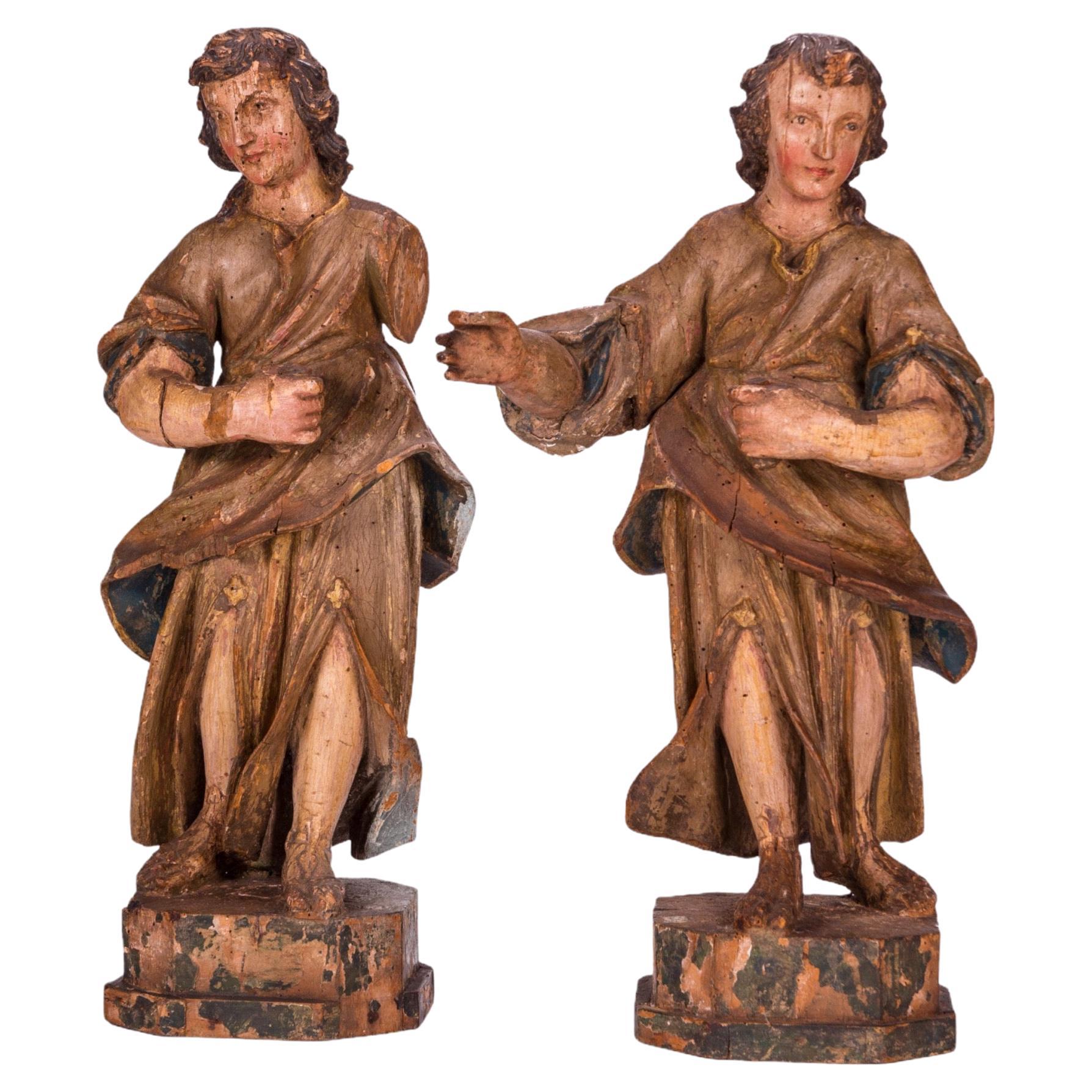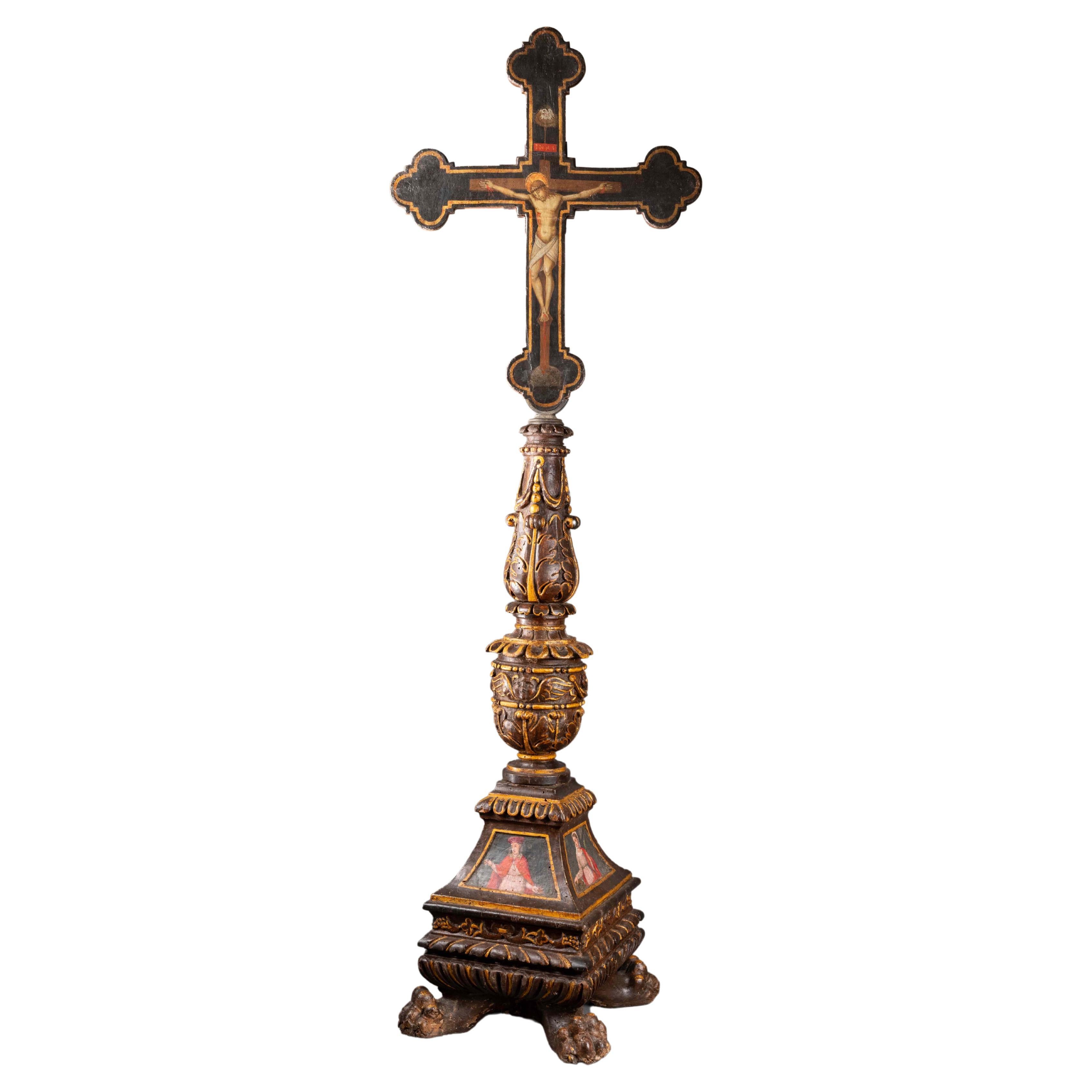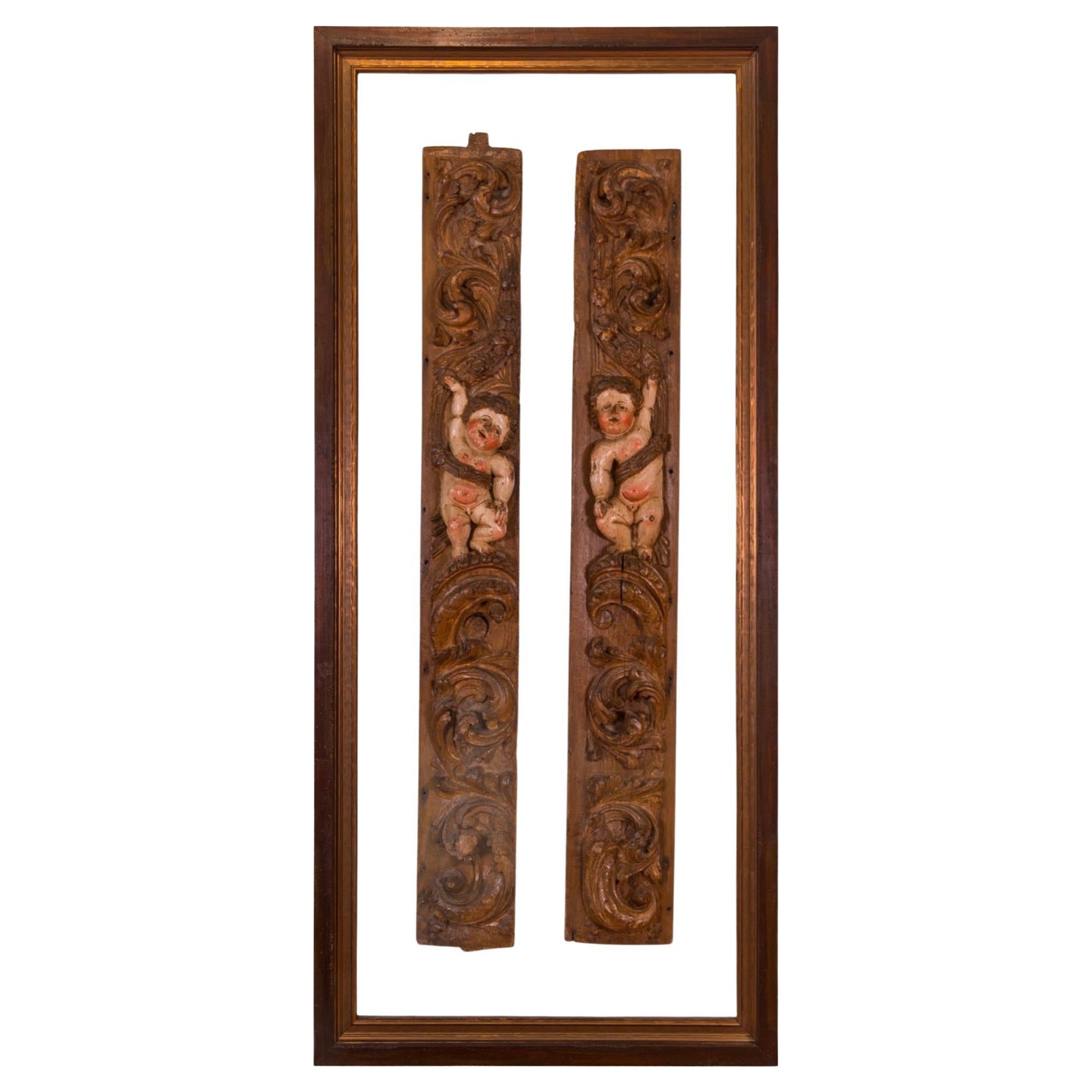Items Similar to 16th Century Hand-Painted and Carved Wood Russian Orthodox Cross
Video Loading
Want more images or videos?
Request additional images or videos from the seller
1 of 15
16th Century Hand-Painted and Carved Wood Russian Orthodox Cross
About the Item
Presenting a remarkable 16th-century Russian Orthodox icon crucifix, a testament to the artistry and spirituality of its era. This meticulously hand-painted and carved wood masterpiece is adorned with three bars, finished in radiant gold gilding, and richly polychromed, making it a truly captivating work of religious art.
The central scene portrays the crucifixion, with figures of Martha, Maria, Johannes, and Longinus depicted beneath the cross. Above, the icon features the symbol of the skull of Adam, representing the triumph over death following the original sin. Atop this iconic composition stands God Sabaoth, flanked by two celestial angels, adding a heavenly aura to the piece.
What makes this icon truly exceptional are the five scenes meticulously depicted from Orthodox festive days, offering a glimpse into the rich tapestry of religious traditions and celebrations.
This Russian Orthodox crucifix not only holds immense historical and spiritual significance but also serves as a work of art that transcends time. Whether displayed for its religious symbolism or appreciated for its artistic beauty, it stands as a testament to the enduring power of faith and creativity across centuries.
- Dimensions:Height: 14 in (35.56 cm)Width: 9 in (22.86 cm)Depth: 1 in (2.54 cm)
- Materials and Techniques:
- Place of Origin:Russia
- Period:
- Date of Manufacture:16th Century
- Condition:Wear consistent with age and use. Minor losses. Minor structural damages. Minor fading.
- Seller Location:North Miami, FL
- Reference Number:1stDibs: LU6132230689252
About the Seller
5.0
Vetted Seller
These experienced sellers undergo a comprehensive evaluation by our team of in-house experts.
Established in 2000
1stDibs seller since 2021
12 sales on 1stDibs
Typical response time: <1 hour
- ShippingRetrieving quote...Ships From: North Miami, FL
- Return PolicyA return for this item may be initiated within 2 days of delivery.
More From This SellerView All
- Angelic Carved Wood Sculptures, 16th CenturyLocated in North Miami, FLPair of 16th Century Italian carved polychromed angelic sculptures.Category
Antique 16th Century Italian Renaissance Figurative Sculptures
MaterialsGold Leaf
- Omnipresence of God, 16th Century, Carved Wood PanelLocated in North Miami, FLA pair of 16th Century Spanish altar panels of Cherubs Representing the Omnipresence of God mounted on a Lucite panel with a double frame of hand-carved ...Category
Antique 16th Century Spanish Wall-mounted Sculptures
MaterialsGold Leaf
- Christ Carrying His Cross, 17th Century, Carved WoodLocated in North Miami, FL17th Century Italian wood image of Christ carrying his cross to calvary mounted on a hand-painted black panel and framed with a modern gold gilded hand-finished wood frame.Category
Antique 17th Century Italian Baroque Wall-mounted Sculptures
MaterialsGold Leaf
- 19th Century Russian Empire Carved Wood Candle Holder SculptureLocated in North Miami, FL19th Century Russian Empire carved wood candle holder / plant stand. It has been modeled after a lion perched on a ball holding a white gold...Category
Antique 19th Century Russian Animal Sculptures
MaterialsWood, Giltwood
- Sculpture of John The Baptist, 16th CenturyLocated in North Miami, FLEarly 16th Century Spanish gold gilded and polychromed carved wood sculpture of John The Baptist.Category
Antique 16th Century Spanish Renaissance Figurative Sculptures
MaterialsGold Leaf
- 17th Century Carved Wood and Polychromed of Crucified Jesus on the CrossLocated in North Miami, FLIntroducing a captivating 17th-century Italian carved wood and polychromed, gold-gilded crucifix depicting Jesus on the cross. This remarkable piece...Category
Antique 17th Century Italian Baroque Figurative Sculptures
MaterialsMetal
You May Also Like
- 16th Century German Hand Carved Painted Wood St. SebastianLocated in Marbella, ES16th century German hand carved painted wood St. Sebastian.Category
Antique 16th Century German Religious Items
MaterialsWood
- Misericord. Carved wood. 16th century.Located in Madrid, ESChoir Mercy. Carved wood. Century XVI. Carved wooden Misericordia that surely belonged to a choir stall (see the upper flat part, which acts as a seat), decorated with a figurative ...Category
Antique 16th Century European Renaissance Figurative Sculptures
MaterialsOther
- Angel, Carved and Polychrome Wood, 16th CenturyLocated in Madrid, ESAngel. Carved and polychrome wood. Century XVI. Polychrome wood carving showing an angel, with the face facing the viewer and the body in pr...Category
Antique 16th Century Spanish Renaissance Figurative Sculptures
MaterialsWood
- renaissance wooden candelabrum and painted cross - Umbria, 16th centuryLocated in Bruxelles, BEBase of a carved wooden candelabrum, polychrome and gilded; cross painted on both sides. Umbria or Tuscany, 16th century 136 x 43,5 x 30 cm (The cross and the base of the candelabrum were later assembled) The base of the candelabrum is intricately carved and adorned with polychrome and gilded finishes. The shafts take on the shape of balusters reminiscent of ancient columns, feature ornate foliage decorations, garlands and winged cherub faces. The feet are crafted in the likeness of lion paws. The base is further embellished with depictions of four saint martyrs, among them Saint Barbara and Saint Catherine of Alexandria. The plasticity of the figures, outlined with strong contour lines, the clear and vibrant colors, are stylistic elements linked to the Umbrian tradition of the sixteenth century.The precisely defined and elegant drawing, along with the clear color palette applied with refined chiaroscuro modulations, became the signature of a style that would leave a lasting mark on the era to come. This is exemplified by a preference for vibrant, multicolored images, accentuated in this case by the use of red and pink in the saint's attire. A notable addition, introduced later, is a polylobed cross painted on both sides. On one side, the Crucifixion is vividly portrayed:The treatment of the corpus itself is in line with High Medieval practice, emphasizing pathos by showing Jesus dead, his arms sagging from the weight of the body. The upper section displaying a pelican pecks at her breast to feed her young with her own blood; a symbol of the sacrifice of Christ on the cross whose body and blood similarly nourishes the celebrant during Mass. The lower part depicts Golgotha. On the reverse side, the Resurrection is artistically presented in a Renaissance iconography, reminiscent of the renowned composition painted by Piero della Francesca, now housed in the Civic Museum of Sansepolcro. In terms of composition, with the frontal depiction of Christ holding the banner, this motif became particularly widespread in central Italy, spanning from Tuscany to Umbria throughout the 16th century.. The double-sided construction suggests that it may also have been carried in liturgical processions. In Umbria from the 14th century, the use of portable crosses painted on both sides had become a widespread practice, aimed at satisfying the monastic clientele that had significantly increased following the establishment of new religious communities. The earliest surviving Tuscan painted crucifix represent Christ as Christus Triumphans, or the “Triumphant Christ” with his head up and eyes open. This form was supplanted in the 13th century with the Christus Patiens, or “Suffering Christ” type who is shown often with his head fallen on his shoulder and his eyes closed, as In our cross. The iconography of the suffering Christ appears to have developed out of a new interest in Christ’s human nature, the development of the feast of Corpus Christi and with increased importance given to the Eucharist. The process of humanizing the figure of Christ reaches its peak with the abandonment of all the previous expressive conventions in favor of more realistic details we can observe in this Crucifix, such as the swollen belly, the arms stretched to the limit of muscle tearing, the body falling heavily forward, the abundant blood on the wounds, and the cross firmly embedded in the rock of Calvary. It's worth noting that Renaissance candelabra...Category
Antique 16th Century Italian Renaissance Figurative Sculptures
MaterialsWood, Giltwood
- Renaissance Period Hand Carved Oak Panels, 16th CenturyLocated in Beuzevillette, FRSet of two 16th century oak panels, one representing a character accompanied by a dog, the other a character in flames, probably saints. These ...Category
Antique 16th Century French Renaissance Figurative Sculptures
MaterialsOak
- Large Tibetan Carved Wood Phurba 15th-16th CenturyLocated in Dallas, TXA large carved wooden purbha sculpture Tibet 15th - 16th Century With the triangular blade issuing from the mouth of a makara, the grip with stylized endless knot, the finial with t...Category
Antique 16th Century Tibetan Tibetan Figurative Sculptures
MaterialsWood





